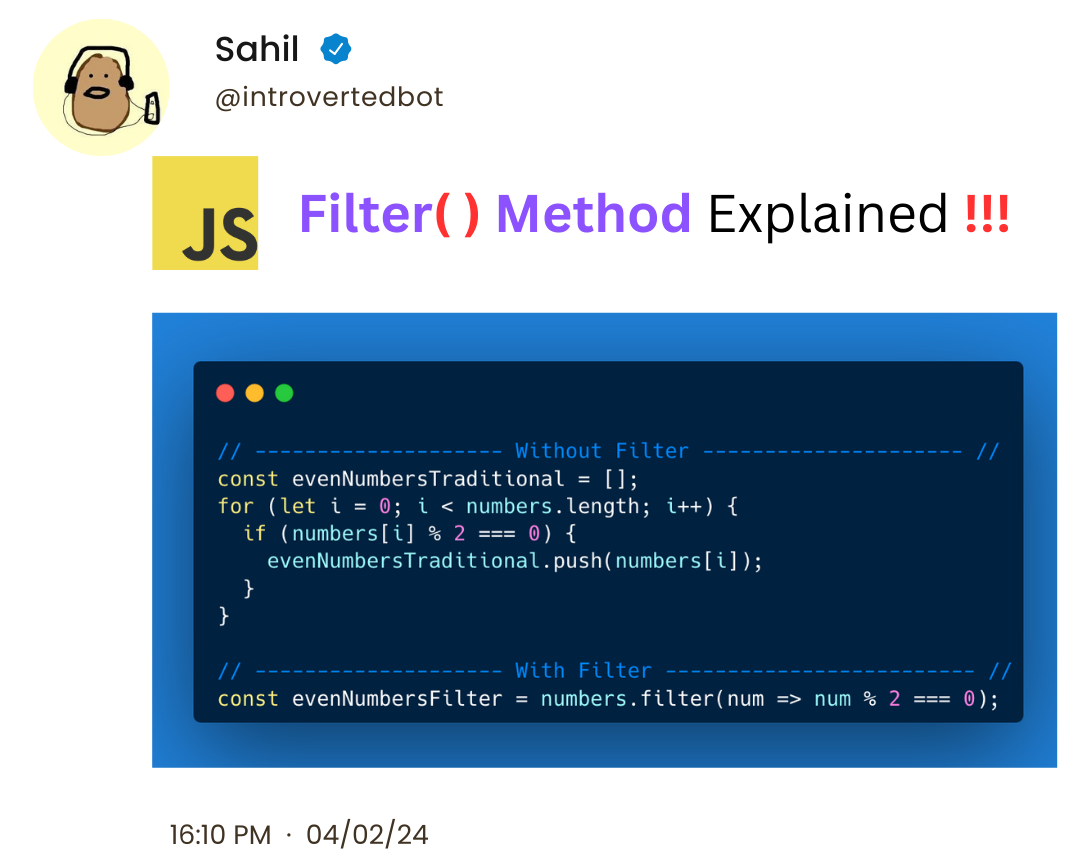How the JavaScript Filter Method Works – Explained with Code Examples

[ad_1]
JavaScript’s filter method serves as a powerful tool for selectively extracting elements from arrays based on certain conditions.
Introduced alongside other array methods in ECMAScript 5, the filter method has since become a fundamental feature in JavaScript programming.
In this article, we will delve into the JavaScript filter method, exploring its syntax, functionality, and common use cases.
Table of Contents
filter Method Basics
The filter method in JavaScript is designed as a higher-order function that iterates over each element of an array, allowing developers to apply a specific condition to filter out elements.
The filter method doesn’t modify the original array, but instead creates and returns a new array containing only the elements that meet the specified condition.
Syntax of the filter Method
The syntax of the filter method is relatively straightforward:
const newArray = array.filter(callback(element[, index[, array]])[, thisArg]);
array: The original array from which elements will be filtered.callback: A function that is executed on each element of the array.element: The current element being processed in the array.index(optional): The index of the current element being processed.array(optional): The arrayfilterwas called upon.thisArg(optional): An optional object to whichthiscan refer in thecallbackfunction.
Common Use Cases of the filter Method
Filtering Based on a Condition
Scenario: You have an array of numbers and you want to filter out only the even numbers.
Without Filter:
const numbers = [1, 2, 3, 4, 5];
const evenNumbers = [];
for (let i = 0; i < numbers.length; i++) {
if (numbers[i] % 2 === 0) {
evenNumbers.push(numbers[i]);
}
}
// evenNumbers: [2, 4]
In the traditional approach, you would iterate over each element in the numbers array using a loop and manually check if each number is even before pushing it into the evenNumbers array.
With Filter:
const numbers = [1, 2, 3, 4, 5];
const evenNumbers = numbers.filter(num => num % 2 === 0);
// evenNumbers: [2, 4]
Utilizing the filter method, you can pass a callback function that tests each element (num) of the numbers array and only keeps the ones that satisfy the condition of being even. This results in a concise and readable way to filter the array.
Filtering Out Null or Undefined Values
Scenario: You have an array containing both numbers and null or undefined values, and you want to filter out these null or undefined values.
Without Filter:
const values = [10, null, 20, undefined, 30];
const filteredValues = [];
for (let i = 0; i < values.length; i++) {
if (values[i] !== null && values[i] !== undefined) {
filteredValues.push(values[i]);
}
}
// filteredValues: [10, 20, 30]
In the traditional approach, you would iterate over each element in the values array and manually check if each element is not null or undefined before pushing it into the filteredValues array.
With Filter:
const values = [10, null, 20, undefined, 30];
const filteredValues = values.filter(value => value !== null && value !== undefined);
// filteredValues: [10, 20, 30]
By leveraging the filter method, you can provide a concise callback function that filters out null or undefined values from the array, resulting in cleaner and more maintainable code.
Filtering Objects Based on Property Values
Scenario: You have an array of objects representing products, and you want to filter out products with prices greater than $50.
Without Filter:
const products = [
{ id: 1, name: 'Product 1', price: 40 },
{ id: 2, name: 'Product 2', price: 60 },
{ id: 3, name: 'Product 3', price: 30 }
];
const expensiveProducts = [];
for (let i = 0; i < products.length; i++) {
if (products[i].price > 50) {
expensiveProducts.push(products[i]);
}
}
// expensiveProducts: [{ id: 2, name: 'Product 2', price: 60 }]
In the conventional approach, you would iterate over each product object in the products array and manually check if the price of each product is greater than $50 before pushing it into the expensiveProducts array.
With Filter:
const products = [
{ id: 1, name: 'Product 1', price: 40 },
{ id: 2, name: 'Product 2', price: 60 },
{ id: 3, name: 'Product 3', price: 30 }
];
const expensiveProducts = products.filter(product => product.price > 50);
// expensiveProducts: [{ id: 2, name: 'Product 2', price: 60 }]
Using the filter method, you can provide a succinct callback function that filters out products with prices greater than $50, resulting in cleaner and more expressive code.
Conclusion
The filter method in JavaScript provides a concise and efficient way to selectively extract elements from arrays based on specified conditions. Understanding its syntax, functionality, common use cases, and best practices empowers developers to write cleaner, more maintainable code.
By leveraging the filter method, developers can streamline their array manipulation tasks and improve the overall efficiency of their JavaScript applications.
If you have any feedback, then you can DM me on Twitter or LinkedIn.
[ad_2]
Source link
